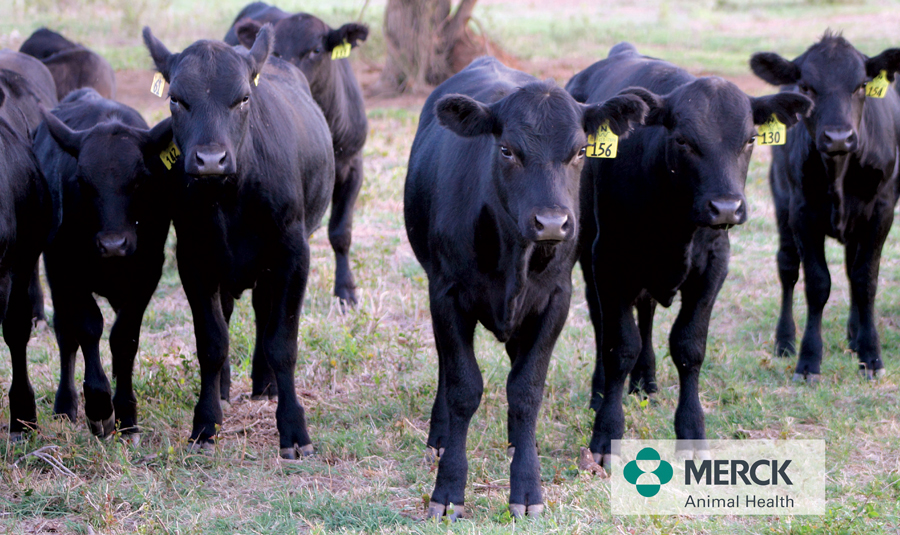A Shorter Calving Season May Bring Improved Breeding Stock and Better Calves

By Ellen H. Brisendine
How long is your calving season? 100 days? Shorter? Longer? In this first month of the new year, Todd Bilby, associate director of Ruminant Technical Services at Merck Animal Health, suggests that this might be a good time to consider the benefits of a 60-day calving season.
With a strict culling philosophy, healthy bulls and a couple of tools you might not have considered, a calving season can be shortened, the breeding herd can be improved and the rancher can produce better quality calves.
“A short calving season gives the rancher calves that are more uniform in age and weight, which generally sell better. And a short calving season, timed to take advantage of peak forage production, may result in a natural increase in the weight of calves because of the top forage conditions,” Bilby says.
There are good reasons to consider a short calving season, but change can be challenging. Bilby has some suggestions about how to approach shortening the breeding season and the subsequent calving season.
“The time it will take to change from, let’s say, a 100-day calving season to a 60-day season, will depend on how aggressive you want to be in reaching this goal.
“My first recommendation is to maximize the first breeding attempt,” he says. This means making sure your bulls are healthy and in great physical condition, that the cows and heifers are in a body condition score of 5 or 6, and that the bulls and females have had the vaccinations to help them withstand the stresses of production.
Sound and interested bulls
Work with your veterinarian to get a breeding soundness exam (BSE) done on your bull well before breeding season so if your bull fails the exam, there is time to test him again or get a replacement bull acclimated to your ranch.
Check your bull’s interest in his job. Bilby says, “Some figures would suggest that around 1 out of 10 bulls lack the desire to impregnate a cow. If you’re using 3 or 4 bulls, and you happen to have one of those lazy bulls, now you’ve dropped your bull power 25 or 30 percent. That’s going to really affect your calving rate.”
Cull that open cow
Take a hard look at the cows that don’t breed back. “How long are you going to let her sit out there in the pasture and be unprofitable?” Bilby asks. Culling a cow when she comes up open allows the herd owner to replace the open cow with more productive females.
Bilby suggests a technique being used by ranchers with short breeding seasons to administer prostaglandins to “help get the cows to show heat more quickly.
“Discuss this option with your veterinarian. If you use this technique,” he says, “make sure you have plenty of bull power to cover the cows that are going to show heat in the shorter time frame.”
Usually, the bull to cow ratio is 1 bull to 25 to 30 cows. If prostaglandins are used, lower that ratio to 1 bull to 15 cows to make sure the cows are covered, he says.
Bilby strongly recommends a whole-herd health vaccination program, “And the reason I say whole-herd is, don’t forget the bulls. A disease outbreak can cause huge losses. If you’ve worked to shorten your breeding season and then you have a disease outbreak, you’ll just have to start over to try to make it all happen again.”
Develop a vaccination plan with your vet
Consult with your veterinarian to make sure your cattle are protected against the common diseases in your area. “All places and parts of the U.S. are going to be a little different in the diseases they see. Protect your herd against the major diseases — lepto, vibrio, brucellosis, IBR and BVD, all of which can cause major reproductive losses.
“I consider the vaccinations for these diseases to be an inexpensive insurance tool compared to the cost of an outbreak that causes an abortion storm and calving losses in a year. Sit down with the veterinarian once a year and make sure the vaccination program is where it should be.”
Estrus synchronization and AI?
Consider adding estrus synchronization and artificial insemination (AI) to your breeding program, Bilby says.
This technique is becoming more popular among commercial beef herd owners to increase first-calf heifer productivity. After the heifers are inseminated, turn them out with the herd bulls. “We are seeing more commercial ranchers using this technique on their mature cows, too.”
Artificial insemination allows ranchers to improve the herd genetics for a reasonable price. “You can pick some of the best, proven bulls, which will allow you to introduce really good genetics into the herd,” he says.
Online breeding season planning tools
Visit beefrepro.unl.edu to learn more about estrus synchronization and AI. Bilby says the Applied Reproductive Beef Cattle Strategies website has been developed by the Beef Reproduction Task Force and the site is housed by the University of Nebraska-Lincoln; however, the task force is made up of reproduction experts from around the U.S.
“It has some great resources for ranchers,” he says, such as recommended protocols for both cows and heifers in an easy-to-use sheet. “The site also offers an Estrus Synch Planner that users can download. The Planner prompts you to answer certain questions. Once you are done, you click it to run, and it will automatically put it on the calendar, and it will tell you how much it’s going to cost, what the benefits are, what the pitfalls could be.”
The AI Cowculator is another downloadable program that will help you decide if AI is right for your herd and budget. “It will take you through prompts to compare if you’re trying to decide between AI or bulls. It will ask you how much you will spend on bulls, what is the salvage value of the bull, and other factors. The software will tell you if it’s more profitable to use AI based on the numbers you entered.”
Well fed
Support all the management tips Bilby suggests with a solid nutrition program. Properly nourished cows are more likely to cycle on time for the next breeding season. Heifers need the right nutrition to be at 60 percent of their mature body weight to cycle on time for breeding season.
“Just like with the bull breeding soundness exams being done well ahead of time, that same philosophy applies to nutrition. Make sure these animals are going to hit the weight that they need to be at when you want to start breeding season,” Bilby says.
Bilby can be reached at the addresses below. Learn more about Merck Animal Health at merck-animal-health-usa.com.
“Shorter Calving Season” is excerpted from the January 2018 issue of The Cattleman magazine.


